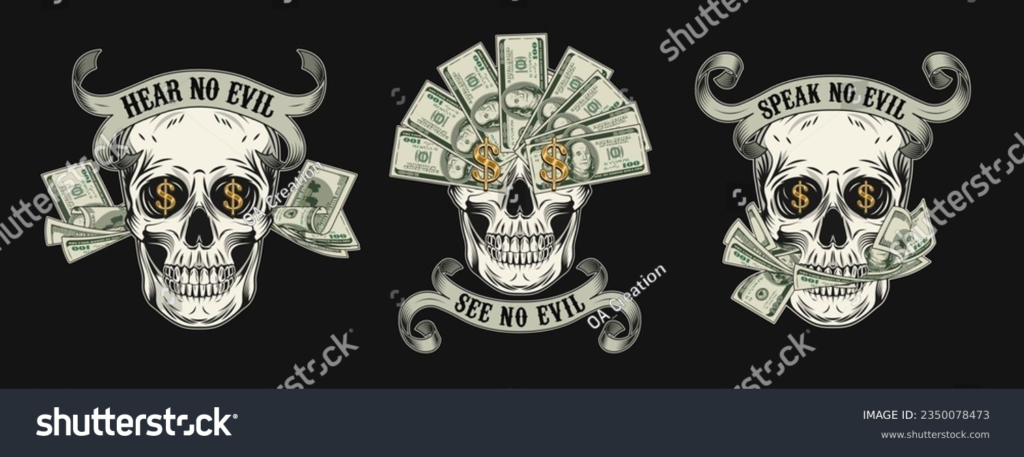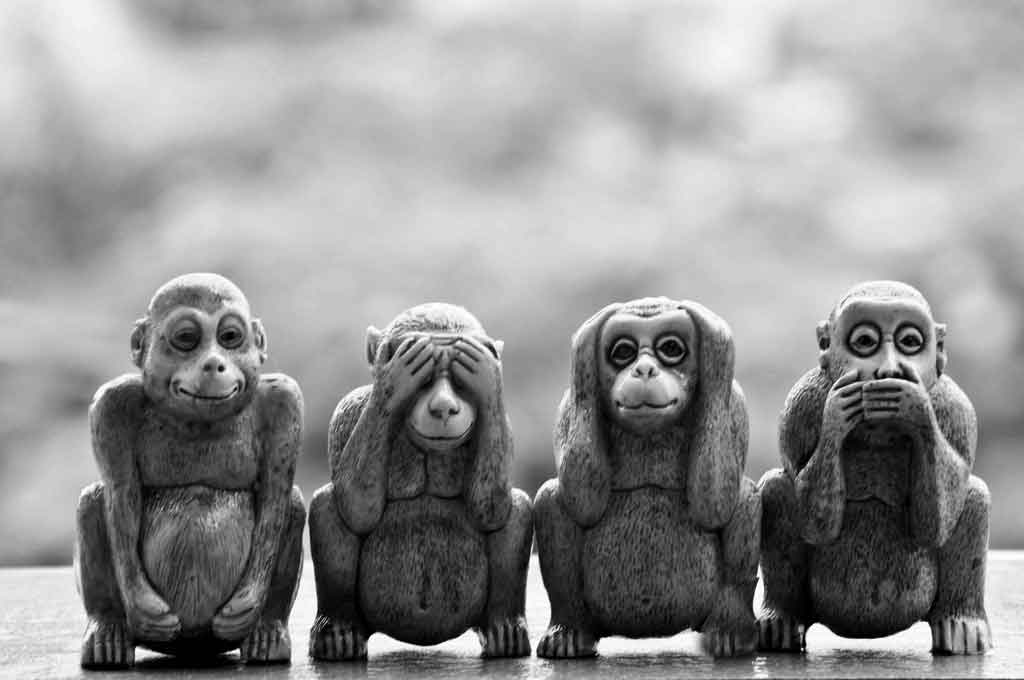The four wise monkeys are a Japanese pictorial maxim, embodying the proverbial principle “see no evil, hear no evil, speak no evil, do no evil“. The four monkeys are
- Mizaru (見ざる), who sees no evil, covering his eyes
- Kikazaru (聞かざる), who hears no evil, covering his ears
- Iwazaru (言わざる), who speaks no evil, covering his mouth.[2]
- Sezaru, who symbolizes the principle of “do no evil”, covering its genitals.
The opposite version of the three wise monkeys is more popular. In this case, one monkey holds its hands to its eyes to focus vision, the second monkey cups its hands around its ears to improve hearing, and the third monkey holds its hands to its mouth like a bullhorn. Another modern interpretation is “Hear, see, and speak out loud for what you stand for”.
The source that popularized this pictorial maxim is a 17th-century carving over a door of the Tōshō-gū shrine in Nikkō, Japan. The carvings at Tōshō-gū Shrine were carved by Hidari Jingoro, and believed to have incorporated Confucius’s Code of Conduct, using the monkey as a way to depict man’s life cycle. There are a total of eight panels, and the iconic three wise monkeys picture comes from panel 2. The philosophy, however, probably originally came to Japan with a Tendai–Buddhist legend, from China in the 8th century (Nara Period). It has been suggested that the figures represent the three dogmas of the so-called middle school of the sect.
There are various meanings ascribed to the monkeys and the proverb, including associations with being of good mind, speech and action. The phrase is often used to refer to those who deal with impropriety by turning a blind eye.
- In Buddhist tradition, the tenets of the proverb are about not dwelling on evil thoughts.
- The proverb and the image are often used to refer to a lack of moral responsibility on the part of people who refuse to acknowledge impropriety, looking the other way or feigning ignorance
Outside Japan the monkeys’ names are sometimes given as Mizaru, Mikazaru[5] and Mazaru,[6] as the last two names were corrupted from the Japanese originals.[7][8] The monkeys are Japanese macaques, a common species in Japan.
See no evil (Mizaru)
We were told to pay attention to people and location(s). The idea was that if we were in the right location, we would minimize seeing trouble develop before our eyes. This was applicable in school and at work. We were instructed against being at the wrong place at the wrong time or the wrong place right. We were also told not to look for bad things in people or in certain situations. There are people who see bad things when they don’t exist, which could explain the manifestations of bias, stereotypes and profiling. We were not taught to be naïve, but to be careful and respectful.
Hear no evil (Kikazaru)
We were told to shield ourselves from bad language and bad intentions. We should stay away from people who spoke ill of others and gossiped. If we were not in the wrong place we could minimize hearing things that we should not hear. We were also instructed not to listen to foul or vulgar language. If we heard people language, especially regarding someone’s evil intentions, we could use the evil information to do good or to help others, that would be permissible.
Speak no evil (Iwazura)
Speak no evil was used to discourage gossiping or speaking ill will about someone. We were told to watch our language and to speak kind words. “If you can’t say anything good about someone, don’t say anything” was a part of this same philosophy. Adults told us that spreading bad news or malicious information could come back to haunt us. We should also, apply this same advice to the workplace.
There is a misconception around the concept about someone. This misconception has led people to adopt a code of silence in the workplace when a person is not pulling their own weight. We would rather silently complain or resign, before talking about an employee who was not working. We would not want to be labeled a snitch or a stool pigeon. In the streets people would say, “snitches get stitches”. To speak evil of someone means telling a lie, varying false witness or defaming their reputation. However, it is our responsibility to find a way to report injustice, illegal behavior and practices that undermine people and the organization. Our intention should be to speak the truth in love without malice or premeditated negative objectives.
One way to break the code of silence is by offering incentives to whistleblowers. These individuals are people who step forward and report unlawful activities in an organization. They are generally paid a 10% bounty if the measure goes to court and fines are levied against the lawbreakers. In neighborhoods where people know the perpetrators of violence, but fail to come forward, there are no such incentives. Residents may be afraid of retribution, as the rationale for their silence. We must also realize that justice requires telling the truth and this should not be regarded as speaking evil of someone.
Four wise monkeys Buddhist principle
Many of us are familiar with the Three wise monkeys representing Buddhist religion principle of non-doing three evils. In particular, “see no evil”, “hear no evil”, and “do not speak of evil”. Monkeys Mi-zaru, Cica-zaru and Yves-zaru “hide” from evil, closing the mouth, eyes and ears. And we often meet their images in sculptures and figurines, as well as copied and parodied ones. However, they also have a fourth friend, whose image we meet much rarer. Meanwhile, forgotten Sedzaru embodies the principle of “do not commit evil,” and the arms cover belly or crotch area. Since the Japanese consider the number 4 unlucky, fourth, though the most important monkey, is mentioned very rarely. Sezaru is forth wise monkey who disappeared from history a long time ago. Now is the time for Sezaru to speak the truth, this is the time when the world needs him. The three wise monkeys represent three core principles – “see no evil, hear no evil, speak no evil” but none of them act in order to stop the violence which is an embodiment of evil in the world.
The fourth monkey’s actions are truly related to the others. The workplace is a common place for the four monkeys to be used as an operating system. Employee bullying and intimidation, sexual-harassment claims, the presence of racial discrimination, unconscious bias and sexually charged language and actions exists in many organizations. Where improprieties and liberties are taken with people’s rights in the form of disrespectful words and actions, there are laws in place to prevent and punish these actions. Employees, who adopt a see no evil, hear no evil, speak no evil mindset are not helping to develop a positive company culture or a respectful workplace
Do no evil is a perfect monkey to enforce the values of character and integrity. He reminds us of proper behavior and etiquette. Our choices have consequences and the more we can emphasize a positive corporate culture and a respectful workplace the more effective our organizations will be become. There is conduct and behavior norms which must be identified, emphasized and enforced vigorously. Character will minimize stress in the workplace and reduce the number of lawsuits and discipline related to improper behavior.
The do no evil mindset would influence our participation in the political process. Our dialogue in conversations around those who are different from us or have different opinions would be positively affected. If we operated each day thinking in terms of do no evil, we would be more empathetic in understanding of each other. We would put ourselves in the shoes of our neighbors and seek to understand their point of, listen to their words and lay the foundation for greater chemistry instead of conflict.
How can we create an environment in our workplaces, families and communities, where people are held accountable for their own unlawful actions and the private citizens who come forward can feel safe and protected? If the fourth monkey was modeled, we would have less of a cause to talk about Mizaru (see no evil) and Kikazuru (hear no evil).
Do no evil and speak no evil should be magnified and connected to many of our guiding principles of behavior. The Golden Rule and its equivalent in many cultures advise us to treat people the way we want to be treated. The Platinum Rule which asks us to treat people the way they want to be treated. The 10 Commandments implores us not to do a series of acts which could be seen as evil, such as murder, stealing, etc. you are instructed to love your neighbor as yourself. If we began from a position of love it is easier to think in terms of speak and do no evil.
The phrase see no evil, hear no evil, speak no evil has come to mean something different than was originally intended. In the West, the proverb see no evil, hear no evil, speak no evil means to turn a blind eye to something that is legally or morally wrong. In this case, a person who will see no evil, hear no evil, and speak no evil pretends that he has not witnessed wrongdoing, and therefore abdicates all responsibility in righting a wrong.


Conclusion
Don’t listen to slander or any evil gossip. Don’t imagine people to be bad when they’re not. Not everyone is out to get you. Do not spread idle gossip or rumours about others. If you can’t speak in a positive, constructive, solution-oriented way, keep quiet.
Remember your spiritual picture. You are an evolving energy pattern, a soul, a free spirit. You are here for your own convenience to learn life lessons and do your life purpose. You are responsible for all your thoughts, feelings and choices. Keep thoughts positive, feel the love of the universe within you and be the best person you can be.
Credits
Orlando Ceaser 2018. The 4th Monkey – “Do No Evil”
Home
“Mikazaru – Google Search”. www.google.com.
Oldest reference of the incorrect Mazaru in Google Books. Source:
Anderson, Isabel (1920). The spell of Japan. Page. p. 379.
Worth, Fred L. (1974). The Trivia Encyclopedia. Brooke House. p. 262. ISBN 978-0-912588-12-4.
https://www.shutterstock.com/image-vector/labels-skull-cash-money-100-dollar-2350078473
